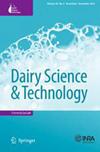Mastitis: Impact of Dry Period, Pathogens, and Immune Responses on Etiopathogenesis of Disease and its Association with Periparturient Diseases
Q2 Agricultural and Biological Sciences
引用次数: 3
Abstract
Mastitis is an inflammation of the mammary gland initiated by pathogenic bacteria. In fact, mastitis is the second most important reason for the culling of cows from dairy herds, after infertility. In this review we focus on various forms of mastitis, including subclinical and clinical mastitis. We also stress the importance of the dry-off period as an important time when pathogenic bacteria might start their insult to the mammary gland. An important part of the review is the negative effects of mastitis on milk production and composition, as well as economic consequences for dairy farms. The two most important groups of bacteria that are involved in infection of the udder, Gram-negative and Gram-positive bacteria, are also discussed. Although all cows have both innate and adaptive immunity against most pathogens, some are more susceptible to the disease than others. That is why we summarize the most important components of innate and adaptive immunity so that the reader understands the specific immune responses of the udder to pathogenic bacteria. One of the most important sections of this review is interrelationship of mastitis with other diseases, especially retained placenta, metritis and endometritis, ketosis, and laminitis. Is mastitis the cause or the consequence of this disease? Finally, the review concludes with treatment and preventive approaches to mastitis.乳腺炎:干燥期、病原体和免疫反应对疾病发病的影响及其与围产期疾病的关系
乳腺炎是由致病菌引起的乳腺炎症。事实上,乳腺炎是奶牛被淘汰的第二大原因,仅次于不孕不育。在这篇综述中,我们关注各种形式的乳腺炎,包括亚临床和临床乳腺炎。我们还强调干枯期的重要性,因为这是一个重要的时间,致病菌可能开始对乳腺的侮辱。该审查的一个重要部分是乳腺炎对牛奶生产和成分的负面影响,以及对奶牛场的经济后果。两组最重要的细菌,参与感染的乳房,革兰氏阴性和革兰氏阳性细菌,也进行了讨论。尽管所有奶牛对大多数病原体都有先天免疫和适应性免疫,但有些奶牛比其他奶牛更容易感染这种疾病。这就是为什么我们总结了先天免疫和适应性免疫的最重要组成部分,以便读者了解乳房对致病菌的特定免疫反应。本综述最重要的部分之一是乳腺炎与其他疾病的相互关系,特别是保留胎盘,子宫炎和子宫内膜炎,酮症和板炎。乳腺炎是乳腺炎的原因还是后果?最后,综述总结了乳腺炎的治疗和预防方法。
本文章由计算机程序翻译,如有差异,请以英文原文为准。
求助全文
约1分钟内获得全文
求助全文
来源期刊

Dairy Science & Technology
农林科学-食品科技
CiteScore
2.30
自引率
0.00%
发文量
0
审稿时长
2 months
期刊介绍:
Information not localized
 求助内容:
求助内容: 应助结果提醒方式:
应助结果提醒方式:


